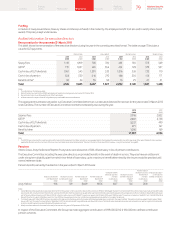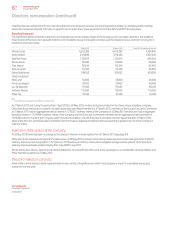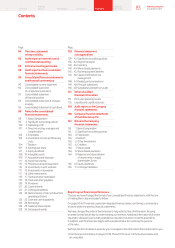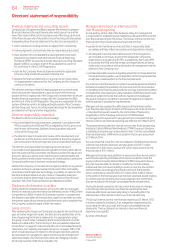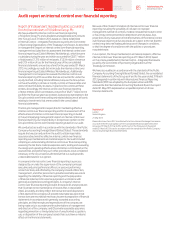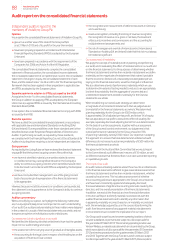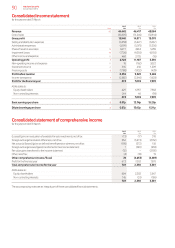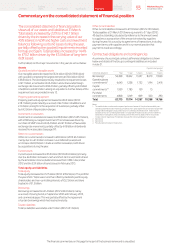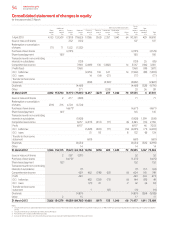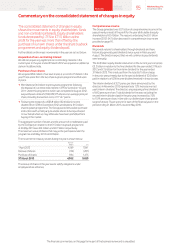Vodafone 2013 Annual Report Download - page 88
Download and view the complete annual report
Please find page 88 of the 2013 Vodafone annual report below. You can navigate through the pages in the report by either clicking on the pages listed below, or by using the keyword search tool below to find specific information within the annual report.
The Group prepares its consolidated nancial statements in accordance
with IFRS as issued by the IASB and IFRS as adopted by the EU,
the application of which often requires judgements to be made by
management when formulating the Group’s nancial position and
results. Under IFRS, the directors are required to adopt those accounting
policies most appropriate to the Group’s circumstances for the purpose
of presenting fairly the Group’s nancial position, nancial performance
and cash ows.
In determining and applying accounting policies, judgement is often
required in respect of items where the choice of specic policy,
accounting estimate or assumption to be followed could materially
affect the reported results or net asset position of the Group; it may later
be determined that a different choice would have been more appropriate.
Management considers that certain accounting estimates and
assumptions relating to revenue, taxation, business combinations,
intangible assets (goodwill and nite lived assets), property, plant and
equipment, provisions and contingent liabilities, and impairment are its
critical accounting estimates.
A discussion of these critical accounting estimates is provided
below and should be read in conjunction with the disclosure of the
Group’s signicant IFRS accounting policies provided in note A2 to the
consolidated nancial statements.
Management has discussed its critical accounting estimates and
associated disclosures with the Company’s Audit and Risk Committee.
Revenue recognition
Arrangements with multiple deliverables
In revenue arrangements including more than one deliverable,
the deliverables are assigned to one or more separate units
of accounting and the arrangement consideration is allocated to each
unit of accounting based on its relative fair value.
Determining the fair value of each deliverable can require complex
estimates due to the nature of the goods and services provided.
The Group generally determines the fair value of individual elements
based on prices at which the deliverable is regularly sold on a standalone
basis after considering volume discounts where appropriate.
Gross versus net presentation
When deciding the most appropriate basis for presenting revenue
or costs of revenue, both the legal form and substance of the agreement
between the Group and its business partners are reviewed to determine
each party’s respective role in the transaction.
Where the Group’s role in a transaction is that of principal, revenue
is recognised on a gross basis. This requires revenue to comprise
the gross value of the transaction billed to the customer, after trade
discounts, with any related expenditure charged as an operating cost.
Where the Group’s role in a transaction is that of an agent, revenue
is recognised on a net basis with revenue representing the margin earned.
Taxation
The Group’s tax charge on ordinary activities is the sum of the total current
and deferred tax charges. The calculation of the Group’s total taxcharge
necessarily involves a degree of estimation and judgement inrespect
of certain items whose tax treatment cannot be finally determined
until resolution has been reached with the relevant tax authority or,
as appropriate, through a formal legal process. The final resolution of some
of these items may give rise to material profits, losses and/or cash flows.
The complexity of the Group’s structure makes the degree of estimation
and judgement more challenging. The resolution of issues is not
alwayswithin the control of the Group and it is often dependent on the
efciency of the legal processes in the relevant taxing jurisdictions
in which the Group operates. Issues can, and often do, take many years
to resolve. Payments in respect of tax liabilities for an accounting period
are made by payments on account and on the nal resolution of open
items. As a result there can be substantial differences between the tax
charge in the consolidated income statement and tax payments.
Recognition of deferred tax assets
The recognition of deferred tax assets is based upon whether it is more
likely than not that sufcient and suitable taxable prots will be available
in the future against which the reversal of temporary differences can
be deducted. To determine the future taxable prots, reference is made
to the latest available prot forecasts. Where the temporary differences
arerelated to losses, relevant tax law is considered to determine the
availability of the losses to offset against the future taxable prots.
Signicant items on which the Group has exercised accounting
judgement include recognition of deferred tax assets in respect of losses
in Germany and Luxembourg and the recognition of a deferred tax asset
in respect of capital allowances in the United Kingdom. Theamounts
recognised in the consolidated nancial statements in respect of each
matter are derived from the Group’s best estimation andjudgement
as described above. See note 7 to the consolidated nancial statements.
Recognition therefore involves judgement regarding the future nancial
performance of the particular legal entity or tax group in which the
deferred tax asset has been recognised.
Historical differences between forecast and actual taxable profits have not
resulted in material adjustments to the recognition of deferred taxassets.
Business combinations
The recognition of business combinations requires the excess of the
purchase price of acquisitions over the net book value of assets acquired
to be allocated to the assets and liabilities of the acquired entity.
TheGroup makes judgements and estimates in relation to the fair value
allocation of the purchase price. If any unallocated portion is positive
itisrecognised as goodwill and if negative, it is recognised in the
incomestatement.
Goodwill
The amount of goodwill initially recognised as a result of a business
combination is dependent on the allocation of the purchase price to the
fair value of the identiable assets acquired and the liabilities assumed.
The determination of the fair value of the assets and liabilities is based,
toa considerable extent, on management’s judgement.
Allocation of the purchase price affects the results of the Group as nite
lived intangible assets are amortised, whereas indenite lived intangible
assets, including goodwill, are not amortised and could result in differing
amortisation charges based on the allocation to indenite lived and
nite lived intangible assets.
On transition to IFRS the Group elected not to apply IFRS 3, “Business
combinations”, retrospectively as the difculty in applying these
requirements to the large number of business combinations completed
by the Group from incorporation through to 1 April 2004 exceeded
anypotential benets. Goodwill arising before the date of transition
to IFRS,after adjusting for items including the impact of proportionate
consolidation of joint ventures, amounted to £78,753 million.
If the Group had elected to apply the accounting for business
combinations retrospectively it may have led to an increase or decrease
in goodwill and increase in licences, customer bases, brands and related
deferred tax liabilities recognised on acquisition.
Finite lived intangible assets
Other intangible assets include the Group’s aggregate amounts spent
on the acquisition of licences and spectrum, computer software,
customer bases, brands and development costs. These assets
arisefromboth separate purchases and from acquisition as part
of businesscombinations.
On the acquisition of mobile network operators the identiable
intangible assets may include licences, customer bases and brands.
Thefair value of these assets is determined by discounting estimated
future net cash ows generated by the asset where no active market for
the assets exists. The use of different assumptions for the expectations
of future cash ows and the discount rate would change the valuation
ofthe intangible assets.
Critical accounting estimates
86 Vodafone Group Plc
Annual Report 2013





